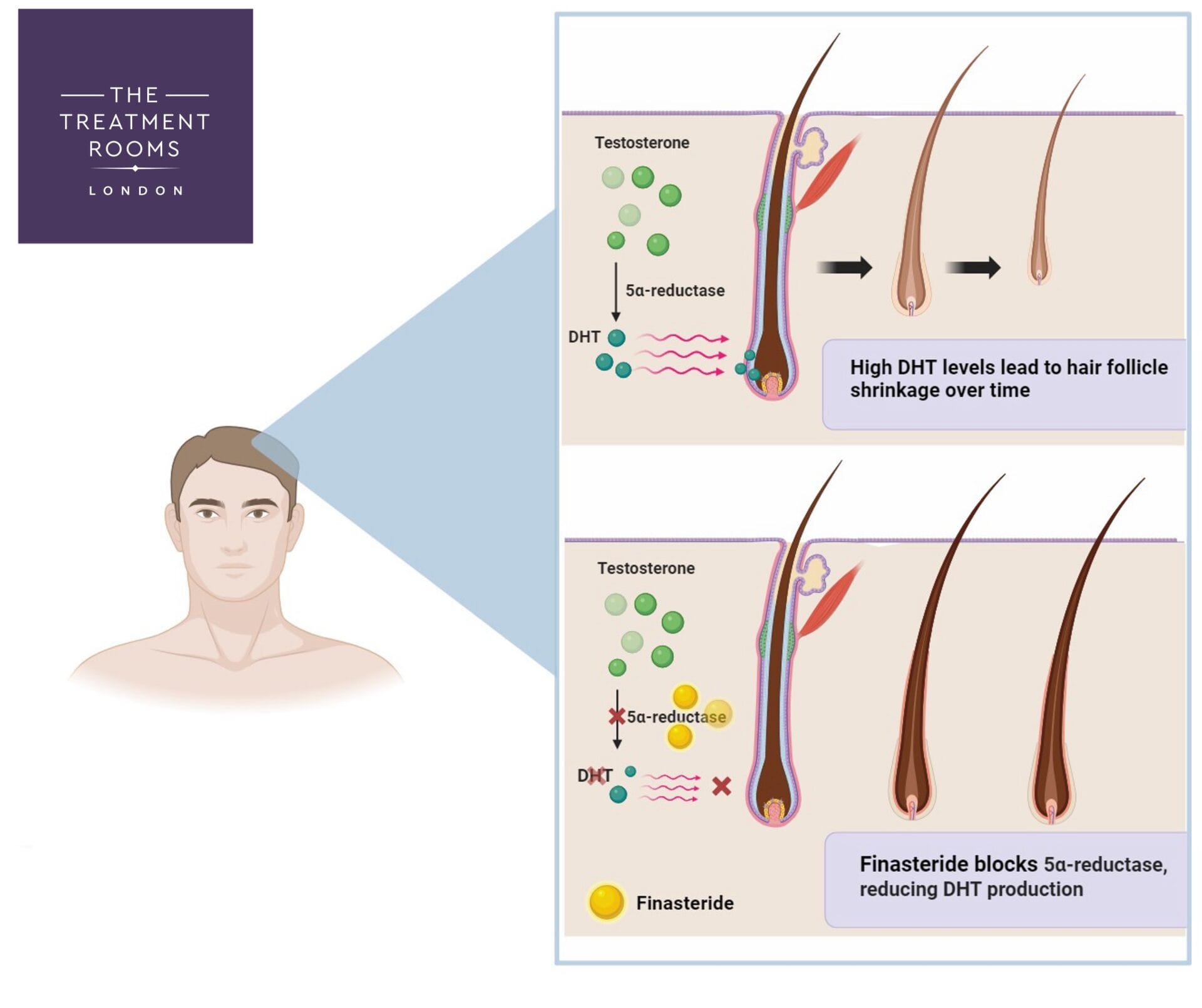Quick Summary: Finasteride And Its Dosage
Understanding Finasteride: Finasteride, a commonly prescribed medication for male pattern baldness, works by inhibiting the enzyme that converts testosterone into DHT, a hormone that contributes to hair follicle shrinkage and loss.
Effectiveness and Dosage: Clinical studies confirm Finasteride’s effectiveness, especially noticeable after 6 months of daily use. The optimal dose for this medication is 1 milligram (mg) per day.
Side Effects and Long-Term Use: While effective, Finasteride can cause some rare side effects such as sexual dysfunction and mood changes. Other more common side effects include skin irritation. These are, however, rare. While these side effects may be rare, exploring the risks and benefits with healthcare professionals on what works best for your future plans is beneficial.
Alternative Doses and Regimens: Lower doses (e.g, 0.2mg) still show benefits, allowing options for those seeking to minimise side effects. Discussing alternative dosing schedules, such as taking Finasteride less frequently (e.g., three times a week), with a healthcare professional is best.
Alternative Treatments: Options like Minoxidil, Dutasteride, and combination therapies can also be effective. Moreover, Topical Finasteride offers similar benefits with potentially fewer side effects.
Key Takeaway: Finasteride is a valuable treatment for hair loss, with how effective it is depending on the dose and whether patients are able to adhere to a treatment plan. Reducing the dose to 3 times a week is worth considering for those concerned about side effects. It’s always better to consult a healthcare professional to tailor a treatment plan to your specific needs and circumstances.
Finasteride has long been used to treat androgenetic alopecia. However, many people wonder if taking it less frequently or at a lower dose would still be effective, primarily due to concerns about side effects and cost.
In this blog, we’ll explore whether lower doses or less frequent use of finasteride can still provide benefits. We’ll compile the current understanding on this topic to help you make an informed decision about your treatment options.
An Overview of Finasteride
What is Finasteride?
Finasteride is a medication primarily used to treat male pattern baldness and benign prostatic hyperplasia (BPH). By blocking a hormone (DHT) responsible for hair follicle shrinkage and hair loss, Finasteride helps promote hair regrowth and preserve existing hair.
How Does Finasteride Work?
Finasteride operates by inhibiting the enzyme 5-alpha-reductase. This enzyme converts testosterone to DHT, a hormone that damages hair follicles and causes them to shrink down until they eventually fall out. By lowering DHT levels, Finasteride can slow, halt, or even reverse hair loss.

Effectiveness of Finasteride
Clinical studies have demonstrated that Finasteride is effective, particularly in men with mild to moderate hair loss at the hairline and crown. Results are most significant after consistent use for 6 months, with visible effects potentially taking up to a year.
Who Can Benefit?
Men experiencing early stages of androgenic alopecia (male pattern baldness) see the most benefit. It is crucial to note that Finasteride is not suitable for treating hair loss caused by chemotherapy, autoimmune diseases, or nutritional deficiencies, and it is still not approved to be used as a treatment for female patterned hair loss (FPHL).
Considerations
The success of Finasteride treatment varies based on age, severity, duration of hair loss, and adherence to the treatment plan. For those with extensive hair loss, Finasteride may serve to preserve hair on the back and sides of the scalp, aiding in hair transplant procedures as well.
Our comprehensive guide on finasteride delves deeper into this medication, and you can have a quick read of it here to learn more.
Recommended Doses for Finasteride
Finasteride is one of the two approved treatments for hair loss, and extensive studies have ensured that the medication’s dose is effective yet safe. Currently, the recommended dose for oral finasteride is 1mg per day, and it needs to be used for at least 3-6 months continuously to see beneficial effects. Daily doses can range from 0.25mg to 1mg, and will vary based on your specific situation and your doctor’s recommendation following a thorough assessment of your hair loss.
At The Treatment Rooms, we would be happy to advise on whether finasteride is the right medication for you, and are happy to discuss any concerns on side effects. Learning how to minimise them, as well as exploring any alternative treatments can be beneficial.
Research Highlights on Finasteride
In case you’re interested, here are some studies that highlight the effectiveness of Finasteride:
- K. Kaufman et al. (1998): Finasteride in the treatment of men with androgenetic alopecia (AGA). Finasteride Male Pattern Hair Loss Study Group.1
- This study analysed data from two clinical trials over the span of two years, involving 1553 men with AGA. Participants received either 1mg finasteride or a placebo (an inactive substance used for comparison).
- Results: Taking 1mg/day Finasteride significantly reduced hair loss compared to the placebo, which still resulted in progressive hair loss.
- Janet L. Roberts et al. (1999): Clinical dose ranging studies with finasteride, a type 2 5alpha-reductase inhibitor, in men with male pattern hair loss.2
- This study compared different doses of finasteride (5mg, 1mg, 0.2mg, 0.01mg per day, and placebo) in men aged 18-36 with moderate AGA.
- Results: 0.01mg/day dose was similar to placebo, meaning it did not show significant improvement against hair loss. However, doses of 0.2mg/day and higher showed positive effects against hair loss. Additionally, the 1mg and 5mg doses were found to have similar effects. The study concluded that 1mg/day is the optimal dose for treating male AGA.
- M. Kawashima et al. (2004): Finasteride in the treatment of Japanese men with male pattern hair loss.3
- This study in Japan involved 414 men experiencing male pattern hair loss, investigating the optimal dosage of finasteride (either 0.2mg or 1mg daily for 48 weeks) against a placebo.
- Results: 54% of men taking 0.2 mg/day showed improvement, while 58% of men taking 1 mg/day showed significant improvement, compared to 6% of men on placebo. The study concluded that 1 mg/day is the optimal dose to promote hair growth and prevent further hair loss. However, we can see that the lower dose still had a positive effect by slowing hair loss and promoting hair growth.
- D’Amico, A., & Roehrborn, C. (2007): Effect of 1 mg/day finasteride on concentrations of serum prostate-specific antigen (PSA) in men with androgenic alopecia: a randomised controlled trial.4
- Serum PSA can be a marker for prostate cancer, and this study tested the serum PSA in men with male pattern hair loss (aged 40 to 60) taking either 1mg/day finasteride or placebo for 48 weeks. With that, they also assessed the safety and efficacy of this dose.
- Results: They concluded that 1mg/day decreases serum PSA by 50%, but more importantly in relation to our topic, it confirmed the safety and efficacy of finasteride at this dose.
- K. Kaufman et al. (2008): Long-term treatment with finasteride 1 mg decreases the likelihood of developing further visible hair loss in men with androgenetic alopecia (male pattern hair loss).5
- Extending their study from 1998, this research analysed data from their previous two clinical trials involving 1,553 men with AGA. The treatment period was extended to observe the effects over a total of 5 years.
- Results: Taking 1mg/day finasteride showed a significant 93% reduction in the likelihood of developing further visible hair loss compared to placebo over the five-year study period.
Summary of research: 1 mg per day is the ideal dose for treating male pattern hair loss. Doses above 0.2 mg were effective to significant degrees, but doses lower than 0.2mg were as effective as a placebo, and therefore not very effective at all. While side effects were noted, the benefits of finasteride generally outweigh the risks, and it is considered safe for use.
In contrast, studies challenge the 1 mg/day dosage recommendation, highlighting the need to reconsider the prescribed dosage based on patient concerns.6 The main areas of concern include:
- Side effects – While rare, the most commonly reported side effects include sexual dysfunction, changes in testosterone levels causing other health conditions (e.g. enlarged breasts in men), depression, allergic reactions. These effects can vary in how often and how severe they are among users
- Long-term effects – Further research into long term effects of Finasteride are required, however the majority of individuals find that their side effects naturally resolve within the first few months of treatment, and also soon after stopping treatment.
It is important to keep in mind that everyone’s hair loss experience is different, and the dosage of finasteride can be tailored to your needs. Your GP, dermatologist, or hair specialists such as The Treatment Rooms, are well-equipped to advise you on this and monitor your progress over several months. They can adjust the dose if necessary, depending on its effectiveness and side effects.
Alternatives to Finasteride
Minoxidil: This is a topical medication, available over-the-counter in 2% and 5% formulations, applied directly to the scalp to stimulate hair growth and slow hair loss. Minoxidil works by encouraging hairs to enter the growth phase of the hair cycle. While effective for many users, minoxidil must be used consistently, as its effects can also take several months to become noticeable.
Dutasteride: Another oral medication that works similarly to finasteride by inhibiting the enzyme 5-alpha-reductase. Its wider targeting of the enzymes makes it potentially more effective. Studies have shown that dutasteride may result in greater hair growth compared to finasteride.7 However, it also has a similar side effect profile, and it is not yet approved for hair loss treatment in all countries.
Combining Finasteride With Other Medications: Combining finasteride with other hair loss treatments, such as minoxidil8, low-dose Dutasteride9, or even new anti-hair loss products (e.g. a topical botanical blend CG210)10 may enhance overall effectiveness. This combination approach targets hair loss through multiple mechanisms—for example, finasteride reduces DHT levels while minoxidil potentially improves blood flow to the hair follicles. Some users find that using both medications together produces better results than using either one alone.
Topical finasteride: Applied directly to the scalp, topical finasteride can be as effective as oral finasteride in reducing hair loss and promoting hair growth.11 The formula is designed to minimise systemic absorption and target the scalp, thereby reducing side effects that affect other parts of the body (systemic side effects) like sexual dysfunction.
Can You Take Finasteride 3 Times A Week?
Taking finasteride 3 times a week (or at a lower/staggered dose) is an option if you prefer to minimise side effects while still remaining effective. However, before changing your regime, we highly recommend discussing this with your healthcare provider or hair specialists like our surgeons at The Treatment Rooms to make sure things are right for you.
It is important to note that if you choose to stop taking finasteride, your hair will likely return to its normal cycle as it was before starting the medication. If you’re concerned about finasteride’s side effects, you might consider alternative treatments such as minoxidil, dutasteride and combination therapies.
The journey to finding what’s right for you can be daunting, but with the right advice and helping hand, there are many approaches one can take to restore hair, health and confidence.
You can learn more about other hair loss treatments in our series of blogs:
- Complete Guide to Hair Loss Treatment
- Guide to Finasteride for Hair Loss
- Can You Take Finasteride with Minoxidil for Hair Loss?
- Stemoxydine for Hair Loss
- Dutasteride: Everything You Need to Know
- The Best Oils for Hair Growth
- Platelet Rich Plasma in Hair Transplantation
- What is Hair Transplant Surgery?
References
- Kaufman KD, Olsen EA, Whiting D, et al. Finasteride in the treatment of men with androgenetic alopecia. Finasteride Male Pattern Hair Loss Study Group. J Am Acad Dermatol. 1998;39(4 Pt 1):578-589. doi:10.1016/s0190-9622(98)70007-6. Available from: https://pubmed.ncbi.nlm.nih.gov/9777765/
- Roberts JL, Fiedler V, Imperato-McGinley J, et al. Clinical dose ranging studies with finasteride, a type 2 5alpha-reductase inhibitor, in men with male pattern hair loss. J Am Acad Dermatol. 1999;41(4):555-563. Available from: https://pubmed.ncbi.nlm.nih.gov/10495375/
- Kawashima M, Hayashi N, Igarashi A, et al. Finasteride in the treatment of Japanese men with male pattern hair loss. Eur J Dermatol. 2004;14(4):247-254. Available from: https://pubmed.ncbi.nlm.nih.gov/15319158/
- D’Amico AV, Roehrborn CG. Effect of 1 mg/day finasteride on concentrations of serum prostate-specific antigen in men with androgenic alopecia: a randomised controlled trial. Lancet Oncol. 2007;8(1):21-25. doi:10.1016/S1470-2045(06)70981-0. Available from: https://pubmed.ncbi.nlm.nih.gov/17196507/
- Kaufman KD, Rotonda J, Shah AK, Meehan AG. Long-term treatment with finasteride 1 mg decreases the likelihood of developing further visible hair loss in men with androgenetic alopecia (male pattern hair loss). Eur J Dermatol. 2008;18(4):400-406. doi:10.1684/ejd.2008.0436. Available from: https://pubmed.ncbi.nlm.nih.gov/18573712/
- Mysore V. Finasteride and sexual side effects. Indian Dermatol Online J. 2012;3(1):62-65. doi:10.4103/2229-5178.93496. Available from: https://www.ncbi.nlm.nih.gov/pmc/articles/PMC3481923/
- Choi GS, Sim WY, Kang H, et al. Long-Term Effectiveness and Safety of Dutasteride versus Finasteride in Patients with Male Androgenic Alopecia in South Korea: A Multicentre Chart Review Study. Ann Dermatol. 2022;34(5):349-359. doi:10.5021/ad.22.027. Available from: https://www.ncbi.nlm.nih.gov/pmc/articles/PMC9561294/
- Chen L, Zhang J, Wang L, Wang H, Chen B. The Efficacy and Safety of Finasteride Combined with Topical Minoxidil for Androgenetic Alopecia: A Systematic Review and Meta-analysis. Aesthetic Plast Surg. 2020;44(3):962-970. doi:10.1007/s00266-020-01621-5. Available from: https://pubmed.ncbi.nlm.nih.gov/32166351/
- Boyapati A, Sinclair R. Combination therapy with finasteride and low-dose dutasteride in the treatment of androgenetic alopecia. Australas J Dermatol. 2013;54(1):49-51. doi:10.1111/j.1440-0960.2012.00909.x. Available from: https://pubmed.ncbi.nlm.nih.gov/22686691/
- Takeda, A., Sato, A., Zhang, L., Harti, S., Cauwenbergh, G., & JiaWei, L. CG210 enables finasteride 1mg users to further improve hair pattern: a randomized, double-blind, placebo-controlled pilot study. Hair Ther Transplant. 2013;3(107):2167-0951. doi:10.4172/2167-0951.1000107.
- Piraccini BM, Blume-Peytavi U, Scarci F, et al. Efficacy and safety of topical finasteride spray solution for male androgenetic alopecia: a phase III, randomized, controlled clinical trial [published correction appears in J Eur Acad Dermatol Venereol. 2023 Feb;37(2):452. doi: 10.1111/jdv.18750]. J Eur Acad Dermatol Venereol. 2022;36(2):286-294. doi:10.1111/jdv.17738. Available from: https://www.ncbi.nlm.nih.gov/pmc/articles/PMC9297965/
Share:
Authored by
Reviewed by
Book a Consultation
Related Blogs
Best Post-Hair Transplant Medication for Effective Recovery and Growth
July 15, 2025
Hair transplant surgery has become one of the most effective and reliable methods for physically reversing hair…
10 Home Remedies for An Itchy Scalp That Actually Work (Backed by Science)
July 15, 2025
Having an itchy scalp is common for most people at some point in their lives. The itch…
Does an FUE Hair Transplant Leave Scars? Myths, Facts & What to Expect?
July 14, 2025
Does an FUE hair transplant leave scars? The short answer to this is yes. All current hair…
Female Pattern Baldness (Androgenetic Alopecia): Symptoms, Causes & Treatments
July 11, 2025
Female pattern baldness, also known as androgenetic alopecia, is a common genetic condition characterised by hair thinning…
What is DHT & Its Role in Hair Loss?
July 11, 2025
Hair loss is a common concern that millions, if not billions, of people experience at some point…
Complete Guide on Folic Acid and Hair Loss
July 9, 2025
Quick Summary Hair loss is a widespread concern that affects millions of people globally. While genetics, hormonal…
Does Hair Dye Cause Hair Thinning? Understanding the Risks and Facts
July 8, 2025
Have you noticed more hair loss after dyeing your hair? The ingredients in some dyes can be…
When Can You Safely Wear a Beanie After a Hair Transplant?
July 3, 2025
Quick Summary Cap Recommendations: Light, breathable caps, such as snapbacks or trucker hats, are advisable if you need…
Castor Oil (Ricino Oil) for Hair Growth: Benefits, Uses & How to Apply for Maximum Results
June 26, 2025
Castor oil, also known as Ricino oil, is extracted from the Castor bean plant (Ricinus communis). During…











